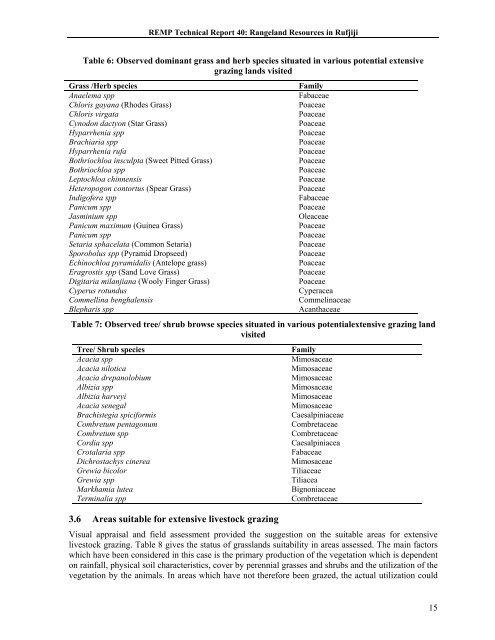rufiji environment management project - Coastal Forests of Kenya ...
rufiji environment management project - Coastal Forests of Kenya ...
rufiji environment management project - Coastal Forests of Kenya ...
Create successful ePaper yourself
Turn your PDF publications into a flip-book with our unique Google optimized e-Paper software.
REMP Technical Report 40: Rangeland Resources in Rufjiji<br />
Table 6: Observed dominant grass and herb species situated in various potential extensive<br />
grazing lands visited<br />
Grass /Herb species<br />
Anaelema spp<br />
Chloris gayana (Rhodes Grass)<br />
Chloris virgata<br />
Cynodon dactyon (Star Grass)<br />
Hyparrhenia spp<br />
Brachiaria spp<br />
Hyparrhenia rufa<br />
Bothriochloa insculpta (Sweet Pitted Grass)<br />
Bothriochloa spp<br />
Leptochloa chinnensis<br />
Heteropogon contortus (Spear Grass)<br />
Indig<strong>of</strong>era spp<br />
Panicum spp<br />
Jasminium spp<br />
Panicum maximum (Guinea Grass)<br />
Panicum spp<br />
Setaria sphacelata (Common Setaria)<br />
Sporobolus spp (Pyramid Dropseed)<br />
Echinochloa pyramidalis (Antelope grass)<br />
Eragrostis spp (Sand Love Grass)<br />
Digitaria milanjiana (Wooly Finger Grass)<br />
Cyperus rotundus<br />
Commellina benghalensis<br />
Blepharis spp<br />
Family<br />
Fabaceae<br />
Poaceae<br />
Poaceae<br />
Poaceae<br />
Poaceae<br />
Poaceae<br />
Poaceae<br />
Poaceae<br />
Poaceae<br />
Poaceae<br />
Poaceae<br />
Fabaceae<br />
Poaceae<br />
Oleaceae<br />
Poaceae<br />
Poaceae<br />
Poaceae<br />
Poaceae<br />
Poaceae<br />
Poaceae<br />
Poaceae<br />
Cyperacea<br />
Commelinaceae<br />
Acanthaceae<br />
Table 7: Observed tree/ shrub browse species situated in various potentialextensive grazing land<br />
visited<br />
Tree/ Shrub species<br />
Acacia spp<br />
Acacia nilotica<br />
Acacia drepanolobium<br />
Albizia spp<br />
Albizia harveyi<br />
Acacia senegal<br />
Brachistegia spiciformis<br />
Combretum pentagonum<br />
Combretum spp<br />
Cordia spp<br />
Crotalaria spp<br />
Dichrostachys cinerea<br />
Grewia bicolor<br />
Grewia spp<br />
Markhamia lutea<br />
Terminalia spp<br />
3.6 Areas suitable for extensive livestock grazing<br />
Family<br />
Mimosaceae<br />
Mimosaceae<br />
Mimosaceae<br />
Mimosaceae<br />
Mimosaceae<br />
Mimosaceae<br />
Caesalpiniaceae<br />
Combretaceae<br />
Combretaceae<br />
Caesalpiniacea<br />
Fabaceae<br />
Mimosaceae<br />
Tiliaceae<br />
Tiliacea<br />
Bignoniaceae<br />
Combretaceae<br />
Visual appraisal and field assessment provided the suggestion on the suitable areas for extensive<br />
livestock grazing. Table 8 gives the status <strong>of</strong> grasslands suitability in areas assessed. The main factors<br />
which have been considered in this case is the primary production <strong>of</strong> the vegetation which is dependent<br />
on rainfall, physical soil characteristics, cover by perennial grasses and shrubs and the utilization <strong>of</strong> the<br />
vegetation by the animals. In areas which have not therefore been grazed, the actual utilization could<br />
15

















